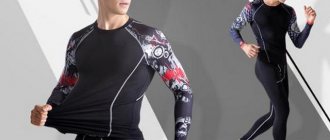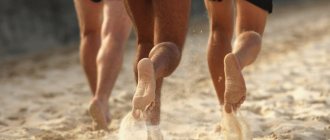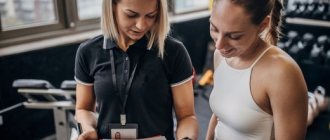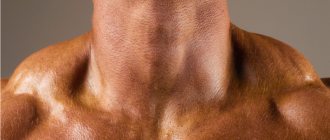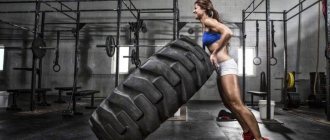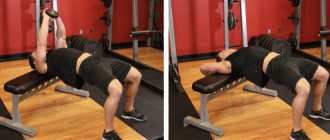Many people, before going to the gym for the first time, doubted whether it was worth going there at all, and imagined all sorts of horrors for themselves. “What if they laugh at me?”, “What if I lift only 2 kg, when everyone lifts 60?”, “What if I look the worst?” — are these thoughts familiar?
This probably sounds funny, but many people really have such fears, and they need to be worked through.
Nadezhda Pozharova
psychologist
There is no shame in being a beginner, there is no shame in not knowing something, not being able to do something. If you really want to, you can learn everything and figure it out.
What to do before your first workout
For most people, consulting a doctor before exercising is not necessary. And in general, the benefits of physical activity significantly outweigh the potential risks of exercise.
Moreover, we have already written in the text “7 signs of proper strength training” that with proper strength training, problems with the musculoskeletal system should decrease.
However, if you have pre-existing health problems, it is recommended that you undergo a preliminary medical examination. In any case, it doesn’t hurt to familiarize yourself with the absolute and relative contraindications to weight training.
Absolute contraindications
• Unstable coronary heart disease,
• Decompensated heart failure,
• Uncontrolled arrhythmia,
• Severe pulmonary hypertension (mean pulmonary arterial pressure >55 mmHg),
• Acute myocarditis, endocarditis or pericarditis,
• Uncontrolled hypertension (> 180/110 mmHg),
• Aortic dissection,
• Marfan syndrome,
• High intensity resistance training (80 – 100% RM) in patients with active proliferative retinopathy or moderate to severe diabetic retinopathy.
Relative contraindications (you should consult your doctor before training)
• Main risk factors for coronary heart disease,
• Diabetes at any age,
• Uncontrolled hypertension (> 160/70 mmHg),
• Low functional abilities,
• Limitation of the musculoskeletal system,
• People with implanted pacemakers and defibrillators.
If you have any doubts, you need to visit a doctor, preferably a sports doctor.
Load testing on a bicycle ergometer or treadmill is carried out as prescribed by a doctor or at your request. Normal results of an electrocardiogram under stress and ultrasound examination of the heart exclude serious risks from training for the cardiovascular system.
Take control measurements : body weight (composition); girths of the chest, waist, hip, shoulder, neck and lower leg; resting heart rate and blood pressure. Zozhnik also recommends
Choose appropriate clothing and shoes . Clothing should be comfortable and not restrict movement (to perform squats and bends with full amplitude). Shoes should be your size, only with laces and preferably with hard, thin soles (with or without a small heel). In addition, in the gym you will need a towel to lay on the backs and/or seats of the exercise equipment. (In general, there is a humorous text about culture in the gym “How not to look like a sucker in the gym” - Zozhnik’s note).
Eat 2-3 hours before class . Don't pass it on. By the time the lesson begins, there should be no heaviness in the stomach. If more than 4 hours have passed since eating, then to prevent a sharp drop in blood sugar levels (hypoglycemia), you should drink a glass of sweet tea, coffee or fruit juice before class and another 200-250 ml during class.
Familiarize yourself with the rules for safe training. There are several rules for safe training in the gym, which, if followed, will help prevent injury and health problems. Familiarize yourself with and adhere to the rules of the gym you work out in.
Rules for safe exercise
• Before starting to work with free weights or on the exercise machine, check the reliability of the locks, the correct installation of the weight, the regulating and limiting movements of the clamps and other devices.
• Prepare a place for studying, make sure that you will not disturb anyone, and also that no one will disturb you.
• Exercises with a significant load or “to failure” are performed only under the supervision of a trainer (instructor). In any case, do not work to failure on your first workout.
• After your approach, you need to return the equipment to its place: put the dumbbells where you took them, and free the barbell from the weights (you read “How not to look like a sucker in the gym”?)
Warm up in the gym
Forget about unnecessary bravado. There is nothing honorable about immediately rushing to the equipment and exercise equipment when entering the gym. Take proper time to warm up. Don't lift as much weight as you can to show others how tough you are. This will only result in all sorts of injuries and sprains. After this, you run the risk of becoming disillusioned with the sport and will return to nurse your tummy in your home chair.
First training. Signs of a good coach
It is better to start any new activity under the supervision of a specialist. The best option for a beginner in the gym is to find a good trainer who will help you avoid mistakes. But unfortunately, this is the biggest difficulty.
Some signs by which you can distinguish a good specialist, according to Sergei Strukov:
• Availability of specialized education and additional training confirmed by certificates of training organizations. For example, if the trainer has an FPA certificate.
• Conducting an initial assessment, and this is, at a minimum: a health questionnaire, motor tests, clarification of training goals.
• Accessible and understandable answers to questions, neat appearance, politeness and attention to you.
In Zozhnik’s opinion, these requirements do not always cut out incompetent trainers (however, an FPA diploma already speaks volumes, pay attention to this). On the other hand, there is no universal answer to how to choose a qualified trainer with a 100% guarantee.
Zozhnik recommends a detailed and understandable text with the opinion of Yaroslava Tareeva “How to choose a coach so that he does not deceive you.”
A bad trainer is worse than self-study . If you exercise yourself, you will be careful and the risk of injury will be lower.
How to dress
Research Enclothed cognition. proved that clothing directly affects psychological processes. Things can put you in the right mood, increase your attentiveness and composure.
You should not wear things that are not intended for sports to training, even if you feel comfortable in them. Buy sportswear, it's not that expensive. You don’t have to choose expensive items from well-known brands, but if you want to wear Adidas or Nike to the gym, check out discount centers: you can buy clothes from sports fashion giants cheaply there.
For women : sports T-shirt or T-shirt made of synthetic fabric, leggings or shorts, sports bra, sneakers. You can also exercise simply in a sports top, without a T-shirt. But remember that if you do burpees, you will have to lie on your bare stomach on the floor.
For men : sports T-shirt, shorts and leggings or pants, sneakers. Some people think that men should wear compression leggings with shorts on top.
Men's gym clothing options
But of course, there is no such rule, so if you want, wear leggings without shorts and just ignore the disapproving looks of some gym visitors.
You will find more detailed tips on how to choose sports items in this article.
Next step: Determine your lesson goals
And immediately a hint in the form of a list of possible goals:
1. Strengthening and maintaining health. 2. Increased strength and/or endurance, improved coordination and quality of movements. 3. Correction of postural disorders, restoration of impaired functions of the musculoskeletal system.
* Sergei Strukov deliberately does not include “increasing muscle mass” in his list of goals - think about it!
Goals define your training program. For example, on Zozhnik there is a section “Ready-made training programs for the fitness room.”
Focus only on the long term
Most people train with some short-term goals in mind. This is not a completely correct approach. Do you understand the difference between short term and long term?
Your goal is not to lose/gain 10 kg in three months. Your goal is to regain and strive to maintain your health for the rest of your life.
Your goal is not 150kg on the bench press. Your goal is to become that guy who never misses a workout.
Your goal is not to sacrifice everything for the best results come spring. Your goal is to become more athletic in the next year. And even more athletic in a year.
Avoid thinking about short-term results. Look at things more broadly, and all these intermediate results will come by themselves.
Stop acting like living a healthy lifestyle is something special. You can go to the gym regularly. This is fine. This is not a sacrifice. Not an obligation. This is fine.
By focusing on the long term, you will see positive changes along the way. Seeing these results, you will understand that everything is going well.
Learning the correct technique
The priority task for beginners in the first months of classes is to learn the technique of performing exercises.
See video examples of all basic exercises with correct technique here.
Priority exercises that you need to master first:
• Squats on one and two legs, • Deadlifts with slightly bent (knees) legs, on one and two legs, • Vertical and horizontal rows, pull-ups (for men), • Vertical and horizontal presses, push-ups, • Walking at speed at least 6 km/h for ≥30 minutes.
Pay attention to the range of motion in the large joints of the body. The size of the weight you use can be increased if you have completed all the planned sets and repetitions of the exercise with a full range of motion.
If your flexibility does not allow you to do the exercises correctly, you need to include stretching exercises in your workout. You can stretch at the end of the lesson (during the cool-down) or separately from the main classes .
See also: “How to stretch properly. 10 videos."
In this case, the frequency of stretching is preferable to the duration of an individual stretch. To increase flexibility, it is better to perform several stretches of 15 seconds each than continuous stretching of the same duration.
Nutrition, shmita and other crap
At the initial stage of training, there is no need to study proper nutrition or run to the store for protein. During the first months of training, your body will change and grow under the influence of unusual (but most importantly correct) loads. You can continue to eat the same food as before you made the decision to become big and strong.
These questions are of course important, but you need to put them off until later so as not to fill your head with unnecessary information. It’s sad, but nowadays most beginners are more interested in the question: what and how to eat in order to grow, than in the training itself.
I can tell you with all responsibility: no matter what you eat, drink or, God forbid, inject - it’s all zilch and a waste of money, unless you know how to train. Without training, you won't grow an inch, even if you eat buckets of protein. In the beginning, you just need to go to the gym regularly and follow the right training program. This is all.
I know a lot of examples when people “blown away” and quit training in less than a month. Although at the beginning there was an impulse, fire in the eyes and attempts to quickly run for protein. Then it began: I can’t do it today, I need to meet a girl, let’s do it tomorrow, it’s summer, let’s go sunbathe, and other excuses.
After the first such excuse, it is already clear that the person will not go to the gym again. And in principle, there is nothing wrong with this; bodybuilding, like any other sport, is not for everyone. Therefore, first check yourself. Go to the gym regularly for at least 3 months without missing a workout. You don't need to buy anything, just a subscription. Walk and train, learn technique, try increasing weights, do basic exercises. If you don’t score after this, then you’ll stay in bodybuilding for a long time.
What does the workout consist of?
Let's be a little banal, but any workout consists of a warm-up, a main part and a cool-down. However, despite the banality, many people forget about the first part, and even more about the third.
Warm-up
Warm-up is necessary to establish the optimal level of thermoregulation and helps to enable the body's functional systems to work. To perform a general warm-up, some kind of cardio equipment is usually used. The duration of the general warm-up is 5-10 minutes.
We recommend in more detail: “Why you need to do a warm-up and cool-down.”
Main part
The most intense and complex exercises are usually planned at the beginning of the class. It is also preferable to teach technique closer to the beginning of training.
A special warm-up establishes an optimal relationship between the structure of the upcoming movement and the activity of the central nervous system. To put it simply: before each exercise, you need to do 1-2 approaches with a weight of 50-70% of the “working” weight in this exercise .
Start any new exercise with a weight that allows you to do at least 20 repetitions per set . Don't rush to increase your working weight.
Ask the trainer (or the instructor on duty - believe me, he will be only happy to help) to check the technique of performing the exercise.
The duration of the main part is on average 30-60 minutes.
Hitch
Cooling down returns the body to a state close to rest. As a cool-down, you can do aerobic exercise of low or gradually decreasing intensity, as well as stretching exercises. The average cool-down duration is 10 minutes.
If you hurry, you will make people laugh
For many people, "working out well" means either doing a very intense workout, experiencing subsequent muscle soreness, or training to failure.
This could be commendable. Desire and ambition in sports are simply wonderful, but first it will be useful to create a certain base, a foundation.
Almost everyone in the gym strives to get to the limit weights as quickly as possible, and this is a very big mistake. At the initial level, you need to give your body time so that it gets used to a new activity and learns to cope with gradually increasing loads. Accelerate little by little and you will avoid injury and pain.
Training to failure is a good way to exhaust yourself without building a strong foundation early on.
At the end of each workout (and each exercise), you need to save yourself the strength for a few more repetitions, while focusing on gradual but steady progress.
This principle works in any exercise. For example, you are doing a barbell curl. For the first workout, you need to take very light weight. Get familiar with the exercise, adjust your technique. It's easier to do this with light weight. Next week, increase the weight a little. It will still be easy for you, and that's okay. Your muscles, joints and ligaments will thank you.
Several weeks have passed and you are still lifting weights that you have no difficulty lifting. All this time you are increasing your potential. And then one week you feel that the ever-increasing weight on the barbell was difficult for you, but you handled it confidently - precisely due to the accumulated potential. And you have a reserve of strength and strength for further progress, because you did not train to failure (that is, you could do more repetitions).
Safety regulations
Principles for safe lifting:
1. During static or dynamic stress, maintain a neutral position of the spine and large joints.
2. Perform the exercises smoothly , without a sharp transition from lowering to lifting, controlling the weight at all points of movement. The average pace of repetitions per set: 2 seconds for lifting and lowering and 1 second each for stopping in the starting and final positions.
3. Start the exercise with a weight that allows you to do at least 20 repetitions without breaking the technique.
Important: learn the concept of neutral spine position, use it during exercises - this will help avoid injury.
Forget about slippers
Seriously, forget it. Are you not at home. Not only does a person in flip-flops or house slippers look extremely unathletic and like a sauna fan, but it is also extremely unsafe. It’s easy to trip in such shoes, after which you can fall onto the nearest exercise machine or jock, who will not like it very much. It will be worse if you injure yourself during exercise.
For training, light sneakers or sneakers with good grip are good. It is also advisable to hide the laces somehow so as not to accidentally step on them.
What to do in the first lesson?
Below are examples of the main part of the lesson for relatively healthy people, aged 16 to 60 years. The proposed options are not a complete training program without adaptation to the individual characteristics of a person. It is highly recommended that you seek professional advice before you begin training.
For the first 2-3 weeks of training, you don’t have to go near the barbell, and if before that you led a sedentary lifestyle for many years, then perhaps longer. During this short period, study the equipment of the gym and learn how to adjust the exercise machines yourself. Don't hesitate to contact the trainer on duty for help.
Take a closer look at the coaching staff, choose convenient days and times for visiting. If there is no trustworthy specialist among the staff, then you will have to engage in self-education and self-training.
Drink about 0.5 liters of still water during your workout (more or less depending on your body weight and ambient temperature, and most importantly, drink as you wish, do not force water into yourself, but do not forget about water completely).
If any exercise causes pain or discomfort, exclude it from the program! It is better to discuss any such episode with a specialist.
All exercises are performed in 2 sets of 10-15 repetitions with a reserve of strength for at least 2 more repetitions in each approach without violating technique .
1. Leg press
2. Calf flexion
3. Horizontal row in the simulator
4. Press in the simulator
5. Vertical row in the simulator
6. Hyperextension.
Don't forget to warm up before and cool down after the main part.
The load should not provoke breath holding . Always exhale with effort .
After the first lesson, you need to pay attention to the manifestations of muscle soreness. If the load is chosen correctly, then the muscles should not hurt. If the pain is minor, you can perform the following exercises with the same volume and intensity of the load.
Don't step over the bar
It is strictly forbidden to sit on the barbell, kick it or step over it. This was done not only because of safety precautions, but also because of folk wisdom. Athletes have an extremely negative attitude towards those who do not respect the barbell. There is a belief that the barbell can take revenge for such a careless attitude. Especially if you stepped not your own, but someone else’s projectile. Previously, they could even give you a slap on the head for this. And a slap on the head of a newbie with the stern hand of a pumped-up kid can really spoil the impressions of going to the gym.
How to regulate training load?
If muscle soreness has disappeared within 48 hours after the first lesson, you can perform 3 sets of each exercise in the second lesson.
With normal load tolerance, it is allowed to perform 6-10 exercises in the main part of the lesson, 2-3 approaches with a rest of 2-3 minutes (until calm breathing is restored) .
The exercises are performed sequentially, that is, the transition to another exercise is carried out after completing all approaches of the exercise.
The number of repetitions per approach is 8-12. In the first approach, at least 12 repetitions are performed, and in the last, at least 8 repetitions. If in the last approach you can do 12 repetitions, then in the next lesson the load must be increased.
Clean up after yourself
No, you don't need to sweep the floor. But if you started an exercise on a barbell, hung the required number of weights on it, and then simply left the barbell on the rack and left, this may cause disapproving glances and exclamations from other visitors to the gym. Always disassemble the barbell, this is considered a rule of good manners.
What might a standard lesson look like for 1 month of training?
The exercises of the program are performed at each lesson, they can be swapped, but you cannot constantly change one exercise to another.
Warm-up • 10 minutes any cardio machine
Main part 1. Leg press 3 (sets) X 8-12 (reps) 2. Calf curls 3 X 8-12 3. Horizontal row 3 X 8-12 4. Push-ups 3 X 8-12 5. Vertical row 3 X 8=12 6. Seated press in the simulator 3 X 8-12 7. Hyperextension 3 X 12-15.
Cool down • 10 minutes, any cardio machine; 2 – 3 stretching exercises
Don't mix up the exercise machines
Usually there is a wide variety of exercise equipment in the gym, but some of them are used exclusively by girls. For example, hip abduction exercises are only suitable for women to remove fat from the buttocks and the surrounding area. Sometimes these machines are used by seasoned professionals to get in shape before competitions. In ordinary situations, men do not use them, and they look extremely comical.
What to do next?
The first month has passed, you have become accustomed to the gym, perhaps you have found a specialist who can evaluate the technique of performing the exercises. If at the same time you continue to train on your own, then you can begin to study the squat/deadlift technique while controlling the neutral position of the spine.
New exercises are introduced into the program one at a time, with a minimum volume of load - 2 sets..
If you decide to start by learning squats, the program might look like this:
Warm-up • 10 minutes any cardio machine
Main part 1. Training in squats 3 X 8-12 2. Curling the legs 3 X 8-12 3. Horizontal thrust 3 X 8-12 4. Push-ups 3 X 8-12 5. Vertical thrust 3 X 8-12 6. Seated press 3 X 8-12 7. Leg press 3 X 8-12 8. Hyperextension 3 X 12-15
Cool down • 10 minutes, any cardio machine; 2 – 3 stretching exercises
Bench squats with back control. Shown are options for holding a stick to control your back position. Holding the stick with a shoulder-width grip above your head helps maintain lumbar lordosis during the squat.
Recommended sequence of inclusion of training exercises in training:
• double leg squats, • single leg deadlifts, • single leg squats, • double leg deadlifts, • shoulder rhythm training (deadlifts first, then presses).
During the period of teaching the technique, exercises are included in EVERY lesson until mastery at an acceptable level . The remaining exercises are optional.
Feel free to ask
Everyone in the hall is equal, no one here will laugh or mock you. If you come to the gym, it means you have taken the first step towards correcting the current situation, and athletes respect such people. There is always a trainer in the gym who will give some advice regarding exercises. If you don’t know how to approach a particular projectile, it’s better to ask so that awkward situations don’t arise later.
Action plan for today
- find a gym in your area (you probably know a couple, but somehow didn’t have time to go there);
- Based on the working hours of the hall, make amendments to your diary (three days a week for 1.5 - 2 hours is enough);
- arm yourself with a notebook and pen, or put a training log on your smartphone;
- create a training plan focusing on basic exercises;
- start training with light weights;
- Gradually increase the load every week.
Good luck with your workout.
Recommendations for enhanced fat burning
To work on accumulated fat, training in the gym alone is not enough.
Trainers advise:
- In the morning, to speed up your metabolism, drink natural coffee on an empty stomach.
- Before breakfast, take a natural amino acid, carnitine supplement and do interval cardio exercise: alternate speeds, or run with fast walking for 1 minute.
- Include 2-3 chicken eggs in your breakfast, adding the whites of another 2-3 eggs and oatmeal, buckwheat or rice porridge.
- It is useful to eat half a citrus fruit and not give up the second breakfast of slow carbohydrates. Stick to 6-8 meals a day with a snack of nuts. Drink water between meals and green tea before training. The diet includes fish, broccoli, milk with 1% fat. Avoid, except after training, confectionery products.
- Before going to bed, satisfy your hunger with lettuce leaves with nuts, flavored with vinegar or lemon juice, or low-fat kefir. Night hunger is removed with casein.
- Pre-workout with a warm-up, because fat begins to be burned at the 21st minute of exercise.
- During training, pay more attention to large muscle groups and use free weights. For one muscle, choose 2 exercises and do 5-6 approaches. Masters advise limiting yourself to 6-7 repetitions in 1 approach, but the last time is done with effort. 1 minute is allotted for rest. It is allowed to alternate approaches with other exercises for quick recovery.
After training, it is useful to eat a piece of fruit or sweets, or drink a whey protein shake. Insufficient sleep, like too much sleep, prevents fat burning.
Tips for beginners
Nutrition
Meals should be as varied as possible so that the body receives all the necessary macro- and micronutrients, as well as fractional ones for better absorption of food, so get used to eating 5-6 times a day, but in small portions.
If you want to reduce weight and volume, you need to consume fewer calories than your body uses. At the same time, focus on foods containing proteins and carbohydrates. This is where, given the current busy lifestyle, carbohydrate and protein shakes can come to the rescue.
For example, 100% natural whey protein from Jarrow Formulas. The lack of flavoring additives in it makes it hypoallergenic. We also need various vitamin and mineral complexes. I love these Nature's Way, Alive!
Water is the source of life
In addition to proper and balanced nutrition, it is necessary to maintain a drinking regime. We consist of 80% water, so all processes in the body occur with its participation, including muscle growth and fat burning.
You need to drink at least 1.5 liters of water per day, but 2 liters is better to maintain normal water-salt balance in the body. Drinking water during training is especially important. So, darlings, don't forget to grab a bottle of Bonaqua before your workout!
Rest
An equally important component is sleep. It is during sleep that the body recovers from the stress received during training and produces hormones that promote muscle growth.
The average sleep duration is 8 hours, but in general this parameter is individual for each person.
Don't be afraid to pump up your muscles and turn into a "man." This will not happen to you if you do not take special hormones.
Clear system
- Without regular fitness classes, you may not expect results, because discipline is an integral part of your progress. Therefore, pull yourself together and move forward, everything depends only on you!
- When exercising with weights, you should follow a certain sequence of actions; this is the key to your athletic longevity. Before starting a workout, it is imperative to prepare the muscles and ligaments for physical activity using warm-up movements (warm-up)
- After completing the main training program, it will be useful to do stretching exercises, but please, without fanaticism
- Clothing for fitness should be comfortable, not restrict movement and made from natural materials to allow the skin to breathe. Therefore, do not skimp on equipment for the gym, health is more important!
Equipment for the gym
The first thing you need to go to the gym is a medium-sized sports bag with side pockets, made of durable fabric and with reliable zippers.
When choosing clothes for the hall, it is worth finding out the dress code of the establishment. If you don’t have it, you should choose sportswear in which you can comfortably perform exercises.
You should choose a cotton T-shirt or tank top to absorb sweat and not restrict movement. Some people wear a simple T-shirt under their T-shirt. If the room is cool, you will need a suit or jacket. The main thing is that things are clean.
For footwear, sneakers with ankle support are preferable. You need to choose a sole that is not hard or slippery and of medium thickness. Socks are required with shoes. Athletes prefer white, but they are allowed to choose the color of their sneakers or trousers.
When performing strength exercises, you need to drink water, so a 1.5-liter container of still water is required. Those who want to train to their favorite music use their own music player. Those who are training to lose weight are advised to take a warming cream.
A small towel is used to wipe the sweaty body, others have to wipe the bench after the previous sweaty person or remove their own sweat. Often such a towel is used to place a barbell on the shoulders under the bar.
Some people use headbands and wristbands to wipe away sweat from their faces. Girls, in order not to shake their hair, do not forget the elastic band; a hairpin is not suitable.
For the convenience and safety of training, sports assistants are used:
- specialized gloves like “ mit en nok ” , but made of thick fabric or leather, against calluses and slipping of projectiles;
- wrist straps made of fabric elastic strips, if the load requires increased weight;
- weightlifting belt to support back muscles and internal organs.
After training, they go to the shower or sauna, so you will need bath accessories: washcloth, gel or soap, shampoo, comb, flip-flops and a towel. Don't forget about a change of underwear.
